| SOIL, FOOD, &
PEOPLE CONFERENCE
March 27-29, 2000 GROW BIOINTENSIVE conference on the U.C. Davis campus
- Introduction
- Presentations
- Additional
Sessions
- Sponsors
- Displays
- Food
A GROW BIOINTENSIVE Model for the New
Century
INTRODUCTION
It was like a cherished dream come true. All
the names seen for so long in the newsletter, directors of GROW
BIOINTENSIVE projects worldwide, old friends of Ecology Action,
Three-Day Workshop participants - as well as leaders in the sustainable
agriculture movement, university professors and small-scale farmers,
were all there, present in one huge room. Two hundred thirty-five
of us from 16 countries and 24 states, ready to learn, share and
network as much as we could during the three days of the March
27-29 GROW BIOINTENSIVE conference on the U.C. Davis campus.
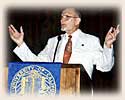 |
| Hugh Roberts, Conference
Chairman, welcoming conference participants |
For some of us the conference began Sunday afternoon as we toured
soil test sites at the University of California Davis campus and
Sunday evening when we met with others who would be support people.
It was exciting to see Joshua Machinga and Emmanuel Omondi there
from Kenya, and Fernando Pia from Argentina. During the course of
the evening, Juan Manuel Martinez walked in with Padre Julio de
la Garza, Gaspar Mayagoitia and Moises Cuevas Vasquez - all GROW
BIOINTENSIVE project directors from Mexico. By the end of the evening,
the room was filled with wonderful people from all over the world.
The main part of the conference was held in the auditorium of Freeborn
Hall. Alice Waters, author and proprietress of Chez Panisse restaurant,
who prepared lunches for participants, surprised us with wonderful
buffet breakfasts served in the lobby of the auditorium. They included
fruit, juices, and a beautiful assortment of freshly baked pastries.
Food from the buffet was also available for snacks during the day.
At the front of the main room were a raised podium
on the right and a raised panelist table on the left. Tables had
been arranged throughout the room diagonally to the front so that
everyone could have a writing/eating space and still see the presenters.
A loudspeaker system distributed sound and also made it possible
for each talk to be taped. On the left side of the room a long table
was filled with Spanish-speaking participants from Mexico, El Salvador,
Peru and Ecuador and their translators. In a raised area on the
right Russian translators served three people, one from Uzbekistan
and two from Armenia. There was also a legal stenographer taking
notes of all the presentations, which will be used to create the
conference proceedings which will be available approximately September
1, 2000 from Ecology Action, 5798 Ridgewood Rd., Willits, CA 95490
for $30 postpaid. Audio tapes may be obtained by contacting: Audio
Productions 1-800-488-5455.
William Lacy, Vice Provost of Outreach and International
Programs at U.C. Davis, gave the welcoming address Monday morning.
The conference chairman was Hugh Roberts, who also chaired the first
and third international conferences on Small-Scale and Intensive
Food Production in 1976 and 1981. Subjects covered during the three
days included the soil's context in sustainable agriculture, water
issues, genetic diversity, farm preservation, nutrition, children's
nutrition, agricultural policy, Biosphere II, growing in a passive
solar greenhouse, and GROW BIOINTENSIVE applications in Mexico,
the Philippines, Russia, Kenya and Argentina.
On the first day, John Jeavons gave two presentations,
about the challenges of the world situation and about the GROW BIOINTENSIVE
solution.

John Jeavons, Director of Ecology Action, during
his opening presentation.
In his presentation, "The Global Farm -
The Challenge", he noted the future landscape before us which
includes the following:
- An average of 45 years of farmable soil remain
globally.
- For each pound of food eaten in the United
States, approximately 6 pounds of this soil are lost due to wind
and water erosion because of the ways we farm.
- Twelve pounds of farmable soil are similarly
lost in developing countries, where 80% of the world's population
currently lives and where 90% will live by the year 2014.
- Eighteen pounds of farmable soil are similarly
lost in China where 20% of the world' people live. o Worldwide,
each person eats approximately 2,000 pounds of food annually.
- This means that per person approximately 6
tons of farmable soil are lost in the U.S., 12 tons in developing
countries, and 18 tons in China each year.
- 30% of the world's cropland has been abandoned
recently in a 40-year period due to severe erosion.
- Approximately one inch of farmable soil
is lost on the average every 28 years in the U.S., 14 years in
developing countries and 7 years in China.
- Yields are down 20% to 60% on degraded
land.
- Approximately 213,000 people are added
to the planet daily.
- This means that approximately 34,000 more
farmable acres are needed each day, or average global yields
need to be increasing significantly.
- Instead, farmable acres and/or the quality
of farmable acres are being lost daily, and yields per unit
of area are not expected to increase significantly in the
near future.
- By 2050 each global citizen on the planet is
expected to have only 25% of the water he or she had in 1950.
- 100% of the Earth's living biomass is expected
to be being manipulated by people as early as 2027 according to
one study.
- In 8 of the 12 years ending in 1998, the world
consumed more food than it produced.
- Therefore, by 2014 only about 41% of the worlds
population is likely to have an adequate diet.
John noted that in the process of the conference
the solutions to these challenges would be discovered - and that
in the future we would be able to live well and equitably while
conserving resources by focusing on having, creating, and growing
enough rather than more.
In Monday's concluding presentation, "GROW
BIOINTENSIVE Agricultural Potential - A Solution", John observed
that:
- many feel that up to a doubling of agricultural
production may be needed as soon as the year 2050,
- the question is whether this can be done without
depleting the world's fragile soil and resource bases and ecosystems,
- approximately half of the world's farmable
soil needs to be left in wild to preserve the planet's plant and
animal genetic diversity.
- The United Nations, in its Agenda 21,
reviewed the world environmental, soil and food situation, and
described desirable goals for future food production. These are:
- reducing chemical use,
- conserving and rehabilitating soil
- improving farm productivity
- conserving plant genetic resources, and
- developing effective organic farming techniques.
Jeavons said that Ecology Action believes that
its "GROW BIOINTENSIVE" agricultural system which it has
been researching, developing and teaching for almost three decades
- if used properly, meets these needs and that it has the capacity
to support ecological balance while doubling the world's food supply.
This method:
- is highly productive,
- is resource-conserving and requires only local
resources,
- is effective without expensive outside inputs
or machinery, allowing many more people to have their own productive
mini-farms,
- promotes a local sharing of regional and national
farming power,
- is environmentally stable and robust,
- contributes to a diverse and strong social
fabric,and
- promotes a healthy environment containing wild
areas for the preservation of plant and animal genetic diversity.
Small-scale, even personal-scale farming is not
a new concept. It is as old as agriculture itself. One study of
15 countries, primarily in Asia and Africa, found that per-acre
output on small farms can be as much as four to five times higher
than that on large ones. Russia, over the years, has often produced
30% to 50% of its food on household plots of less than an acre each
representing as little as 3% to 5% of all Russian farmland. Dr.
Robert Netting, an ecological anthropologist, after decades of field
studies of Nigeria, Mexico, the Swiss Alps and Asia, observes that
small-scale, highly diversified agriculture is the most ecologically
sound, efficient and stable method of food production. The productivity
of small-scale farms is also being widely recognized by agricultural
economists who call it the "inverse relationship between farm
size and productivity."
"GROW BIOINTENSIVE" practices with an
average buildup in skill and soil fertility can enable farmers to
produce approximately double the averages of conventional farming
techniques in a given region, and sometimes more.
Jeavons continued to observe that there are additional
"economies of small-scale" with the "GROW BIOINTENSIVE"
approach. Per unit of production, "GROW BIOINTENSIVE"
can use 67 go 88 percent less water, 50 to 100 percent less nutrient
input in the form of purchased organic fertilizer, and 99 percent
less energy, compared with conventional agricultural practices.
The practical result is that a complete balanced
diet for one person for one year can be grown sustainably - meaning
feeding the soil at the same time with enough carbon - in as little
as 4,000 square feet assuming a vegan diet with a significant number
of calories being obtained from root crops which produce a large
number of calories per unit of area - such as potatoes, sweet potatoes,
burdock, garlic, salsify and parsnips. "GROW BIOINTENSIVE"
has been shown to work well in virtually every climate and soil
where food is grown - and it is being used in over 100 countries.
In the first test in the difficult Siberian climate in 1995, GROW
BIOINTENSIVE growing areas averaged yields that were 286% higher
than US conventional averages. In another test in India, by the
end of the third growing season, low-income families with no previous
farming experience, in sandy soil, and with only fresh manure as
fertilizer, were producing yields that were equal to 75% to 100%
of those being obtained by the good farmers in India. In Mexico,
when the government provides assistance to people with no food,
the cost is reportedly US$800 to 1,000 per person. Yet, GROW BIOINTENSIVE
practices have been taught to people there by the nonprofit organization
ECOPOL at the cost of about US$3.20 per family of six.
Conference participants listen on.
Translators were provided for several languages.
These things are key, because by 2014 the amount
of food-growing area worldwide may well be as little as 9,000 square
feet - and about 4,500 square feet if half of the area is left in
wild to preserve the plant and animal genetic diversity so necessary
to our global ecosystem.
In contrast, current conventional agricultural
methods - both chemical and organic - require approximately 31,000
square feet to grow an average diet - and 7,000 square feet for
a vegan diet.
To meet the world soil challenge, "GROW BIOINTENSIVE"
has the capacity to build up to 1 inch of farmable soil in as little
as 8.5 years and the 6 inches necessary for farming in as little
as 51 years. In contrast, the 6 inches of farmable soil we are depending
on now globally first began being formed 3,000 years ago in 1,000
BC, at a time when the Romans had primitive forms of chariots. In
California, this soil-building process is slower and first began
about 12,000 years ago, in approximately 10,000 BC during a world
period of time known as the Iron Age.
Instead of "growing crops", we need
to start "growing soil", John observed. Fortunately, to
"grow soil" we need to grow crops, so we have not "lost"
anything. Instead, we get both. It's a win-win solution. In the
process, we will have changed our perspective, however. Our goal
will not just be to harvest but to grow soil fertility!
In addition, "GROW BIOINTENSIVE" practices
can significantly help lessen the global warming challenge. If the
whole world were practicing these techniques, we actually could
tie up as much as 30 years' worth of surplus carbon dioxide from
the atmosphere in the form of increased crop biomass per unit of
area and increased organic matter in the soil in the form of compost.
One of the ways in which to grow soil and sufficient
diets in a small area is with the "60-30-10" approach.
60% of the farmÕs growing area is grown in seed and grain
crops, such as maize, wheat and amaranth. These compost crops produce
a significant amount of calories for diet and a large amount of
carbon for compost per unit of area. 30% of the area is grown in
special root crops, such as potatoes and sweet potatoes. These diet
crops produce a large amount of calories per unit of area. 10% of
the area is grown in salad or salsa crops for the additional vitamins
and minerals needed to produce a complete diet.
"The choice is ours", Jeavons continued.
"We can have a century of increasing desertification and increasing
scarcity of per-capita resources, farmable soil and food, or we
can transform the current global challenge into a situation of abundance
and, more important, of enough for everyone.
"As Candide noted, the whole world is a garden.
And what a wonderful place it would be if each one of us took care
of our part of the earth, our garden. It's that simple. That's how
the global challenge can be transformed into bite-sized pieces,
and we can all take responsibility for our piece. "Yet 'GROW
BIOINTENSIVE' practices are not the answer. You are the answer -
each one of us is. It's how we use these practices, to build up
the soil or to deplete it, that will make the difference. We hope
that you will become part of that process."
On Monday and Tuesday evenings, we had a chance
to see displays of some of the small-scale agricultural work being
done in the U.S. and worldwide during the poster sessions. On the
last day, participants broke into small groups to develop recommendations
for GROW BIOINTENSIVE policy and action in the areas of genetic
diversity, networking, nutrition, agricultural policy, research,
training and education, and water.
On Thursday morning, after the official conference
was over, some GROW BIOINTENSIVE practitioners and support people
met for several hours to exchange ideas on teaching, research, funding
and networking.
The U.C. Davis campus was a good place to hold
such a gathering. It is quiet and low-key, with huge old trees that,
according to one Davis resident, are being cared for through a Tree
Save program. Much of the vehicular traffic is bicycles; there are
bike racks of all types and materials everywhere. And the city of
Davis itself has a small-town feel to it.
Mention needs to be made of the wonderful lunches
Alice Waters planned for us. Although a small plate of meat was
present at each meal, most of the foods were wonderfully seasoned
grains, beans and succulent vegetables. Each of the foods Alice
prepared was given a unique taste by the subtle herbs and condiments
added. Many were marinated in olive oil. There was also a new unique
sauce or spread each day which created a good deal of discussion
about what its ingredients might be! French bread, exquisite cookies
and iced tea completed the meal. It was a ten-minute walk from Freeborn
Hall to the campus dining room where we ate. We enjoyed the exercise,
sun and fresh air after so much sitting and focusing on agricultural
issues.
This conference was the result of many years
of planning. It presented the opportunity not only to hear the views
of experts in the field of small-scale agriculture but also to network
with people who are actually out there every day, doing grassroots
work in GROW BIOINTENSIVE mini-farming education as well as a large
number of incredibly well-motivated people from the general public.
We feel sure that the effects of the conference will be with us
for a long time, inspiring greater efforts, connecting us more strongly
with each other, and helping advance the cause of greater food security
worldwide.
After the conference, Kent Whealy of Seed Savers Exchange wrote
us, "I want to tell you and everyone at Ecology Action how
very much I enjoyed participating in your recent conference. I am
sincerely impressed with what you have been able to accomplish.
As speaker after speaker got up and told how hundreds and even thousands
of families are literally able to eat because of your methods, well.....I
didn't really realize."
John Doran of the USDA Agricultural Research Service
wrote that the conference was "... one of the most inspiring
conferences that I have been to in my over 25 years as a scientist
and a lifetime as a person. From my perspective, one of the greatest
threats that humanity and the planet face is in finding resource-friendly
ways of meeting human needs for food and fiber while maintaining
environmental stability and conserving resources for future generations...
We must 'translate our science into practice'. This conference brought
the necessary people together to clearly see that in sustainably
producing food we must use nature as our guide, we must escape from
the poverty of affluence which is always striving to accumulate
more of things you really don't need, and we must 'seize the day'
in recognizing the opportunity for finding a new way of living in
harmony with nature and humankind in the new millennium... The conference
helped me to see the human and earthly needs that are not being
met by our current industrial approaches to agriculture. It also
highlighted that the needs of the poor and disenfranchised can be
met by GROW BIOINTENSIVE agriculture... GROW BIOINTENSIVE agriculture...
does provide a model for the characteristics which a future agriculture
will need to achieve the vision of 'Sustaining the People and the
Land.'"
top
PRESENTATIONS
Click here to close all presentations
Soil: Its Context in Sustainable Agriculture
Soil: Its Context in Sustainable Agriculture
Louise Jackson | Jeff
Mitchell
 |
Louise Jackson is an associate
professor and Cooperative Extension specialist in the Department
of Vegetable Crops at U.C. Davis. For over 10 years she has
conducted a research and teaching program in agricultural ecology
at Davis. |
Her goal is to use her research to improve water
and nitrogen management in vegetable crop systems, so that fertilizer
and irrigation inputs are reduced, and nitrogen losses to the environment
are minimized.
Jackson stated that as a biologist, she is interested
in the life of the soil, and how it changes with more organic matter
input and less pesticide and fertilizer. She is addressing how soil
ecology relates to sustainable agriculture. She said that interactions
in the soil are complex and hard to separate. It is necessary for
researchers to separate soil ecologies into their component parts.
In studying the partitioning and flow of nutrients
among soil, soil biota, atmosphere and ground water, the question
to ask is whether nutrients are retained or lost within the whole
system. In her research, it has been shown that cover crops are
instrumental in keeping nitrates from leaching to the subsoil during
winter rains and that lettuce is particularly efficient in absorbing
nitrogen from a cover crop.
Jackson said:
- they also study the ecology of the soil community, the composition
and interaction of all organisms in the soil, including plants
and how this affects nitrogen cycling,
- this is a very complex system and a difficult area to research,
- markers for soil organism identification are now starting to
be used and that these may eventually serve as fingerprints of
community soil organism composition
- a third area of study used is individual soil organisms and
how they change under various circumstances is a key area being
studied.
top
 |
Jeff Mitchell is a Cooperative
Extension vegetable crops specialist at U.C. Davis' Kearney
Agricultural Center. |
His work emphasizes soil quality assessment and improvement as
well as reduced tillage production systems.
Mitchell said that he has had the opportunity in the past 4 or
5 years to work directly with farmers in a team effort that includes
the USDA and other organizations. He stated that:
- the quality of the soil is the business of everyone at the conference,
- the ability of the soil to sustain its multitude of functions
has come under question, particularly in the last 2 decades, and
- defining soil quality has been a very difficult task.
Mitchell mentioned that on the west side of California's San Joaquin
Valley there was once a wide variety of crops grown, which returned
a great deal of organic matter to the soil. Today that area is mainly
monocropped, leading to serious concerns among its producers about
soil quality. He has been working with 15 farmers in the area to
provide answers about how the regular use of manure, compost and
cover crops affects the soil's organic matter, microbial activity
and fertility. After 3 years, the farmers were using these inputs
70% of the time.
Mitchell also explained how difficult it is to break down the mass
of data collected into component parts. They were testing the soil
for its physical, chemical and biological properties, which he said
had never been done before. At a different test site, near Davis,
they are also experimenting with reduced tillage methods, trying
to discover the optimal tillage to preserve the greatest amount
of carbon in the soil.
top
WATER: ITS CONTEXT IN SUSTAINABLE AGRICULTURE
Jaimie Dunn
 |
Jaimie Dunn works with The Council
of Canadians, a public interest watchdog group with 100,000
members. |
Dunn talked about the worldwide crisis in water
and stated that "corporations, with the help of governments,
are lining up to cash in on the situation," which could speed
up the course of a water-scarce future. He said the World Bank has
called potential world water sales a $800 billion business. He added
that water privatization always leads to huge layoffs and a lack
of public information about water quality.
Dunn noted corporations are gearing up to transport
massive amounts of Canadian water to the U.S., Asia and the Middle
East by supertanker, pipeline and diversion of river systems. "Bladders"
now being constructed to be filled fresh water and towed behind
tankers are 7 football fields long and 4 football fields wide.
Dunn also talked about the bottled water industry,
one of the fastest growing industries in the world. In many Canadian
communities, bottled water companies have obtained the right to
tap water out of underground aquifers, even when those communities
are experiencing water shortages. The high cost of bottled water,
particularly in the Far East where it sells for about $7 a quart,
makes this a lucrative business, even with transportation costs
taken into account.
Dunn mentioned the inefficiency of most water
systems and said that if current technologies were taken advantage
of, agriculture could save 50% of its water and industry could reduce
its water consumption by 50% to 90%. What is missing "is the
political will and vision." He said governments are not enacting
legislation to protect their water systems and in fact are encouraging
the commodification of water.
He described the challenges water faces
under World Trade Organization policies, which will prevent communities
from making decisions about their own water. Dunn ended by saying
we need to adopt a new water ethic based on knowing that water is
part of the earth's heritage and must be preserved not only for
the future generations themselves, but also for the world ecosystems.
He believes this can only occur through communities coming together
to make it happen.
top
Optimal Genetic Diversity
Optimal Genetic Diversity
Raoul Robinson | Hope
Shand | Kent Whealy
 |
Raoul Robinson was formerly with
the U.N. Food and Agriculture Organization. He trained in agricultural
botany at Reading and Cambridge Universities, has worked mainly
with crops in developing countries and is the author of several
books on plant pathology. |
Robinson said that for the last 100 years scientists
have been breeding agricultural crops. However, for 9,000 years
farmers themselves have been successfully breeding new plant cultivars.
Scientific crop breeders had 4 goals - to increase:
- yields,
- quality of product,
- economic sustainability, and
- resistance to pests and diseases.
Robinson believes that they have succeeded in
the first 3 goals but have been "disastrously unsuccessful"
in the last one. He cites the reason as being the domination of
the science since 1900 by Mendelians, who base resistance control
on a single gene.
The problem with this system is that it quickly
breaks down - a type of "boom and bust" - so that that
particular cultivar has to be replaced with another in just a few
years. As a result, in the 1960's plant breeders decided they weren't
going to deal with resistance anymore. They would leave it to the
plant pathologists and entomologists. He believes that is why crop
protection chemicals now have to be used in such great quantities.
Robinson stated there is another type of resistance
control, based on poly genes. This type of cultivar will never break
down and will only get progressively better until it reaches a plateau.
Plant breeding for resistance with poly genes is also very easy
and can be done by anyone.
He mentioned that one of his books, Return
to Resistance, discusses plant breeding clubs. He hopes that eventually
there will be thousands of plant breeding clubs worldwide, each
one producing the best cultivars for its own ecosystem. When this
happens, he feels this process will go a long way towards eliminating
chemicals from crops.
top
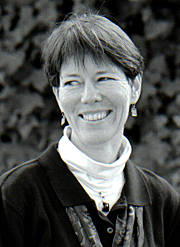 |
Hope Shand is the research director
for the Rural Advancement Foundation International. She writes
on the topics of agricultural biodiversity, as well as the social
and economic impacts of new biotechnologies. She is editor of
RAFI Communique and author of Human Nature: Agricultural Biodiversity
and Farm-Based Food Security. |
Shand mentioned 3 trends she sees as challenges:
The first is an unprecedented rate of erosion of crop genetic resources,
animal species, tropical forests, soil and biodiversity. This cannot
be separated from the breakdown of human cultural diversity: the
loss of traditional farming communities, languages, indigenous cultures,
all on a massive scale. With this loss we also lose scientific information,
innovative capacity and traditional knowledge.
The second trend is privatization of plant genetic
breeding resources and seed sales. She cites gigantic transnational
enterprises which have gained unprecedented control over patents,
food security, farming and health. Shand notes that 20 years ago
there were thousands of seed companies, most of which were small
and family-owned.
Today the top 10 companies control one-third of
the $23 billion commercial seed trade. The same companies now dominate
in all sectors: plant breeding, pesticides, veterinary medicines
and pharmaceuticals. Fewer companies are making decisions about
the future of agriculture worldwide.
The third trend concerns farmers and their role
in using and conserving agricultural biological diversity. In the
long run they are the ones that crop biodiversity depends on, particularly
those farmers in marginal areas.
Shand is alarmed at the erosion of their rights
to save seeds and breed their own crops. This is important because
farmers are plant breeders who are continually improving plants
to fit their own specific conditions. She sees this as the key to
maintaining food security and points out that corporate breeders
are taking out patents on the modification of plants that were originally
developed by farmers over the centuries.
top
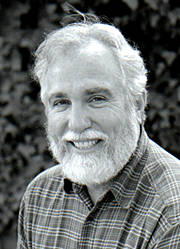 |
Kent Whealy is the director of Seed Savers Exchange, a nonprofit grassroots
network of gardeners, orchardists and plant collectors whose
efforts are saving a significant part of the genetic diversity
of our planet.
Kent has traveled globally to save
thousands of endangered species and is the editor of The Garden
Seed Inventory and The Fruit and Nut Tree Inventory. These
invaluable resources are periodically updated and revised.
They list all the open-pollinated varieties in the United
States that are not extinct and give sources for obtaining
seeds or saplings for these varieties.
|
Whealy started by saying he was glad to be present
on such a "momentous occasion." Then he spoke of the irreplaceable
nature of our genetic wealth, which can only live in living systems
and can disappear in a year. These resources provide a thin line
between us and worldwide starvation.
Whealy traced his involvement with heritage seeds.
It all began 25 years ago when his wife's grandfather gave them
2 varieties of seeds he had brought with him from Bavaria. At the
same time, he read about the erosion of genetic diversity that was
accelerating worldwide.
He realized there must be a tremendous heritage
of heirloom varieties in the country which had been passed down
in families. Immigrants always brought the best of their seeds with
them to provide a tie to their place of birth and to allow them
to eat foods they were used to.
He placed ads in gardening and back-to-the-land
publications, trying to locate more of these seeds and found there
were real "treasure troves" of seeds available, particularly
in isolated areas like the Smoky Mountains.
Today, Seed Savers puts out a 500-page yearbook
listing a network of 1,000 people who have about 11,000 varieties
of seeds not offered commercially. Whealy is pleased that Native
Americans are gradually starting to offer their seedsÑthese
"sparks of life"Ñ to this network.
Seed Savers Exchange, located on a farm in Iowa,
maintains about 18,000 varieties as a central backup collection
for its members and grows out 2,000 of these each summer. Whealy
ended his presentation with a beautiful and inspiring slide show
of some of the amazing varieties of vegetables they have grown out
from their heritage seeds.
top
Urban Farms, Rural Farms, Farmland Preservation
Urban Farms, Rural Farms, Farmland Preservation
Leonard Diggs | Mas
Masumoto | Marty Strange
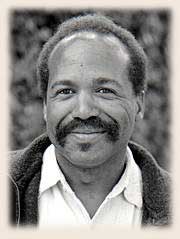 |
Leonard Diggs works his own organic
farm and is also the farm manager of the Santa Rosa Junior College
Shone Farm. He was the recipient of the Pedro Ilic Agriculture
Award for Outstanding Farmer, 1996, and the Outstanding Young
Farmer of the Year Award from the Sonoma County Harvest Fair,
1996. |
Diggs joked about how appropriate his name is
for a farmer, then got down to more serious business. He stated
that the urban recycling mantra is "reduce, reuse, recycle,"
but that in a consumption-based world where only new items are counted
as part of the Gross National Product, it's hard to make reduction
real.
It's like we're all starring in a "B" movie, where we
expect the hero in the white hat to come in and rescue us at the
last moment. At this point, he believes we're looking to biotechnology
to save us.
Diggs stated the rural mantra is "maintainable, sustainable,
organic." He said everyone would have their own list of how
to make that possible, but this is his:
- farmers having sustainable and maintainable lifestyles,
- communities supported by bioregional resources which serve as
successful models of local economic development,
- sustainable positive images of agriculture being projected to
young people through schools and mainstream media, and
- revitalized vocational schools and apprenticeship programs that
would teach young people to maintain first their homes and then
their agricultural resources.
Diggs closed by saying he wanted to use the saying "It takes
a village to raise a child" and modify it to "It takes
a community to maintain a farm."
top
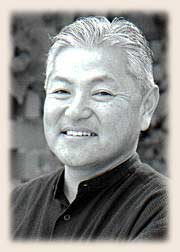 |
Mas Masumoto is an organic farmer
in California's Central Valley. He is a grower spokesperson
for the California Tree Fruit Growers Association and has served
with the Raisin Advisory Board and the California Clean Growers
Association. He was appointed to the California Council for
the Humanities board in 1994 and now serves as its cochair.
Masumoto is the author of Harvest Son and Epitaph for a Peach. |
Masumoto read an excerpt of what he had written
in praise of the peaches he grows. And he emphasized there's only
one way you can grow that type of peach: by farming slow. He said
there is no way you can rush soil, community, diversity or water.
Masumoto does not believe slow is inefficient. He savors his moments
in the field, enjoying his work and reflections of his family farm.
In contrast, he stated that industrial farming
- fast farming - is based on viewing land as a commodity and depersonalizing
those who work it. He does not believe fast is a natural part of
the human rhythm.
Masumoto said he uses his abilities as a writer
to capture the "slow" stories from his farm and communicate
them to the public. For example, pruning is slow, taking years to
learn. Its lesson is about working with the past to shape the future.
He believes that is what the conference is about.
Good peaches embody sensibilities about
food and the memory of how it should taste. He said that 90% of
the population has never tasted a good peach, which he thinks is
scary. Through stories he can convey an understanding for "the
flavor of the land." He would like farming to be again looked
on as an art. Masumoto pointed out he is not anti-technology but
is only seeking a balance to the high speed of technology.
top
 |
Marty Strange is the former
program director of the Center for Rural Affairs. He is a
leader in the movement for social and economic justice and
environmental reform in rural communities. He is the author
of Family Farming: A New Economic Vision, one of the leading
critiques of industrial agriculture. |
Strange believes that when personal responsibility
becomes a political act, there is a great possibility for change.
He used as an example Gandhi, who politicized
the peasants of India by encouraging them to weave their own cloth,
even though this was a function the British claimed the rights to.
This became the emblem of independence in India. He added that he
looks for the day when gardening is considered a political act in
this country.
Strange spoke about the problems of privatizing
land and asked, "To whom do the fruits of the land belong?"
He said economists used to ponder about what gives value. He personally
believes the relationship between place, work, and consumption to
be central to the issue of what gives value to land.
High-yield farming is the name that has been given
to the current industrial-type agriculture. But it also could be
used to describe the agriculture the conference is about, which
gives the returns for the labor and management to the farmer rather
than to the suppliers of high- input technology. Also, this type
of agriculture produces yields from the land by using the soil wisely.
Strange believes that organic farming is becoming
a system that is more about purity and premiums - and so is attractive
to the industrial system - and less about soil health and stewardship.
He feels the vision we need is one which changes the relationship
between people and land and between producers and consumers.
Getting skills into the hands of people who want
to farm in a healthy manner is going to be a crucial issue. He believes
that the largest underused agricultural resource we have is the
urban poor and that with their cooperation the soul of organic gardening
might be salvaged
top
Nutrition
Kate Clancy | Joan
Dye Gussow
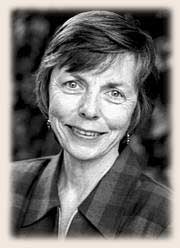 |
Kate Clancy is the Director of
the Wallace Institute for Alternative Agriculture. Before joining
the Institute 3 years ago, she had spent 15 years on the faculty
of the Department of Nutrition and Food Service Management at
Syracuse University. |
Clancy spoke about the 3 major health and nutrition
problems in the world, taken from an article, "Underfed and
Overfed," which appeared in Issue #150 of WorldWatch. These
problems are lack of calories, lack of micronutrients, and overeating.
She feels that iron is the biggest micronutrient problem and that
most micronutrient lack is due to little variety in the diet.
Clancy stated that obesity in essence is caused by nutritional
transition. She said that anyone who moves to a city will increase
his/her consumption of sweets by 100 percent, no matter the level
of income or physical activity. There is also a higher intake of
fats and meat.
When traditional people come as immigrants to the U.S. and start
to make money, they experience a change of diet and in the process,
often lose their health. She notes that in China during a four-year
period, the number of people eating a high-fat diet went from 23%
to 67%.
Another factor in diet change is the changing role of women. When
women work out of the home, there is often a lessened focus on food.
She feels it is important to encourage the return to or retention
of traditional diets.
Clancy cites poverty as being responsible for a lack of calories,
or malnutrition. She says this is basically due to poor people lacking
access to land. She believes there is plenty of food being produced
in the world now and the real problem is to defeat poverty.
She thinks the answer to this is to create farming and marketing
systems which are rooted in the community. Because small-scale,
or traditional, agriculture is labor-intensive, these systems will
provide jobs, produce fresh food for market and also create raw
materials for value-added products.
top
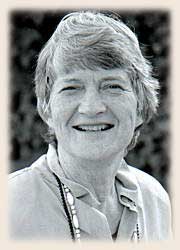 |
Joan Dye Gussow is the Mary Swartz
Rose professor emeritus of nutrition and education at Teachers
College, Columbia University, where she formerly headed the
Department of Nutrition Education. |
Gussow reminisced about meeting John Jeavons in
Palo Alto and watching the food being weighed at the garden there.
She said she appreciates the work that Ecology Action has done so
that others can know nutritional facts about food, such as the fact
that a nutritionally complete diet can be grown in a very small
area.
She noted that adequate calories are the most
difficult nutritional element to grow in a small area, as is vegetable
oil. Gussow has spent the last 5 years growing vegetables on 990
square feet and says that she grows many more vegetables than she
can eat. She plans to intensify her production so that she can also
grow food for the soil.
Gussow feels that our planet is showing signs
of terminal illness and that the current global food system is not
sustainable. Food travels great distances and is tasteless, but
most American consumers do not know this because they have lost
their sense of taste. She believes that things will have to change,
and that when they do, Americans and people in other developed countries
will have the hardest time adjusting.
She said that Americans are accustomed to having
whatever foods they want at any time of the year and views food
education as being a "Rushmorian" task. Her own personal
choice for re-educating people is to invite others to dinner so
they can experience a different kind of diet of fresh food. Some
of the statements made by Clancy and Gussow during questions from
the audience were:
- Encourage people to garden. People who garden
will change their diet.
- There should be a signal that will turn off
the TV and on the screen place a sign saying, "Think."
- It is important to teach gardening in schools,
not only how to grow food, but how to cook it.
top
Children's Nutrition
Padre Julio de
la Garza | Mercedes Torres Barreiro
| Dr. Romolo Rizzo of UNICEF-Mexico/Cuba,
who was originally scheduled to made this presentation, was
given a last-minute assignment in another country. Two of the
conference participants spoke instead.
They
were introduced by Juan Manuel Martinez, who explained that
every six years the Mexican government changes and the people
experience the crises of inflation, devaluation, and greater
malnutrition.
He said that right now people are not able
to afford milk, cheese or meat or even the traditional foods:
tortillas, beans or chiles. Many are forced to exist on noodle
soup, which does not provide needed protein or calories.
He went on to describe
the effects of the first, second and third stages of malnutrition
and still there is another stage called "adaptive,"
where a person adjusts to less food by being smaller and weighing
less. But those people in rural areas who have learned GROW
BIOINTENSIVE methods break this cycle of malnutrition "to
the degree of their efforts". |
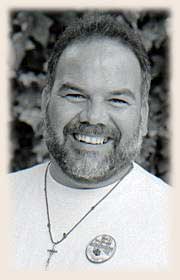 |
Padre Julio Caesar de la Garza,
is one of the biointensivistas, works in Nuevo Leon state, in
a very poor area of Mexico. He told of just starting his priesthood
in 1989 and having a child die in his arms of malnutrition. |
Padre Julio said that he is not an agricultural
technician, but started in his own way to try to plant food in the
desert when "providentially" his bishop received a copy
of How To Grow More Vegetables from John Jeavons. The bishop had
been moved by the saying in the book: "Take care of the soil
and it will feed you."
With two other people he started an organization
called "La Milpa." The first tools they had were made
out of the structure of a former rabbit project. Padre Julio was
ordained and promised himself that he would be a "GROW BIOINTENSIVE
priest."
He and his group started a demonstration garden
in his area and then in another one. He said that in the 10 years
since they started this project, 1,000 farmers have been trained.
Although malnutrition still exists, he continues working to convince
people that GROW BIOINTENSIVE is an alternative for the world, but
especially for the poor.
Someone from the audience asked how you can teach
poor people, when they do not have time to wait for their food.
Padre Julio answered that after only 30 days, a person will have
radishes to eat, and their life changes.
top
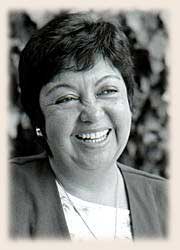 |
Mercedes Torres Barreiro, from
Quito, Ecuador, spoke with such passion that the audience was
deeply moved. |
Torres spoke of the current financial crisis in
Ecuador, "the greatest crisis in all of its history,"
which has left the country in extreme poverty.
Torres said she felt a great responsibility, because
she wanted to be the voice of 9 million Ecuadorians. She described
herself as a wife, mother, and independent Latin American consultant
whose life savings disappeared when the bank failed. She said the
same thing has happened to millions of the men and women of her
country.
Torres talked about going to a restaurant with
her family and ten skinny children peering in the window at them.
Her family took their meal outside and shared it with them. She
also told about people fighting over the food there because "there
is no food in the countryside."
She said people have been left not only without
food but without hope or self-esteem. But they feel that solidarity
among themselves will bring back the hope to their villages. Torres
said that some nuns in a convent close to town have offered 1 hectare
of land where people might grow their food.
She feels that receiving training in the GROW
BIOINTENSIVE method will nourish the bodies and spirits of her people.
She said that even though she does not have a project right now,
5,000 families are expecting an answer from her trip to the conference.
She stated that when there are no economic problems,
we do not believe we need anyone else.
[Note: Over $2,300 was donated by Conference
participants for Padre Julio's and Mercedes' projects.]
top
Agricultural Policy Alternatives
Agricultural Policy Alternatives
Michael Ableman | Martin
Borque
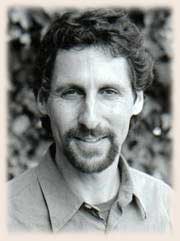 |
Michael Ableman is the founder and director of the Center for Urban Agriculture
at Fairview Gardens, a nonprofit community and education center
near Santa Barbara, California. Through tours, classes and outreach
programs, his farm has become an important national model for
urban agriculture. He has authored From the Good Earth, a photographic
essay about organic farms around the world, and On the Good
Land about the evolution of his 11-acre farm in Goleta, California.
He and his farm are also the subject of an upcoming PBS-TV Special,
"Beyond Organics". |
Ableman said he had a hard time believing that
solutions could come from government. As an organic farmer he has
had to do everything on his own, with no government help.
The message of the 1960's was "Get big or
get out," and this statement is still echoing. He feels that
there is a big-business bias on many levels but that despite this,
there are an increasing number of small producers.
Ableman said that he had hoped that the food system
as a whole would be redefined, but he sees that organic farming
is now big, in the supermarkets, with the same "factory"
consciousness. He believes that the USDA rules do not support small
producers, although the USDA asked for input from them.
He thinks there should be a double system with
a double set of rules, one for large producers and one for smaller
ones.
Ableman feels that consumers are hungry not just
for the food small-scale producers can provide, but for the connections
with them. They want relationships. He thinks the food system is
more than just the responsibility of farmers.
There is a revolution taking place in neighborhoods
and backyards, and this revolution has the potential to address
a multitude of issues. He wants a sense of honor and craft to be
restored to agriculture.
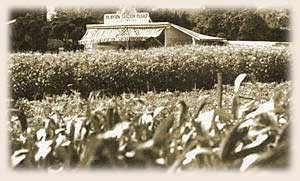
Fairview Gardens, a nonprofit community
and education center located near Santa Barbara, CA. Photo: Michael
Ableman
top
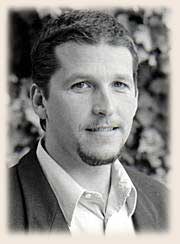 |
Martin Borque works for Food
First. |
Martin spoke of the 50 years of intensive chemical
agriculture in developed countries which have made important increases
in production but have concentrated agriculture in the hands of
fewer people and exacted heavy ecological costs.
He mentioned that in the Central Valley of California,
hundreds of wells have been closed due to contamination. There has
also been poisoning of people working in the fields because of pesticide
drift, in particular methyl bromide. He believes that most of the
solutions to these problems will have to come from communities,
and that this is already a major movement.
Borque wondered what agriculture could be like
if all our national resources were geared up towards changing it.
He has been working with Cuba for 5 years on agricultural exchanges,
and he spoke of what has been happening there as a example of the
possibilities.
In 1989, Cuban governmental policy was that the
country should export sugar and import everything else. Cuba had
one of the highest rates of chemical use in agricultural production.
With the breakup of the former Soviet Union and the resultant shutdown
of imports to Cuba, Cuba had to completely rethink its agricultural
policies.
Leaders from the highest levels of government
met to look at what resources were actually available. Oxen were
substituted for machinery. Research and development centers were
created to work on a biological pest control program.
These centers began to use agricultural waste
to grow biological controls. They also developed microbial fertilizers,
working with the relationships between micro-organisms and specific
crops. There was a massive retraining of professionals.
Borque pointed out that although there was a critical
food shortage in Cuba, government policy was that everyone should
eat, and resources were spread equally.
Cuba also inaugurated an urban agriculture
program in 1993 or '94, and the growing of food in backyards was
encouraged. Large farms were broken up into one-acre pieces or smaller,
and title was given to anyone who wanted to produce food. There
are now extension agents who have been trained in the new methods
who work with these farmers. There is a farm market program whereby
food is sold directly to consumers and organic farm supplies are
available in stores.
top
Soil Quality Options
John Doran | William
Horwath | Kate Scow
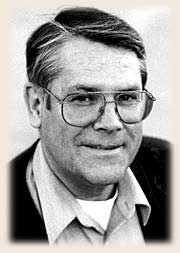 |
John Doran is
a soil scientist and professor of agronomy at the University
of Nebraska, Lincoln. For over 25 years, he has conducted research
on microbial ecology as it relates to the development of sustainable
management systems which enhance soil quality, economic crop
production and environmental quality. |
Doran mentioned first that it is only when we
get together like this at larger venues that we realize how little
we as individuals know. He stated that a major challenge of sustainable
agriculture is translating science into practice.
He told the story of how, while studying agronomy
at the university, he had received "his first lesson in soil
microbiology" helping his future father-in-law plant potatoes.
Mistakenly tamping the soil after each potato was planted, he was
told about the geology, climatic conditions and soil needs of that
particular plot of earth, by a man who had only graduated from fourth
grade.
Doran gave that as an example of how we, with
all of our advanced technology, have gotten away from a basic understanding
of the natural world.
Doran stated that though industrial agricultural
practices have increased productivity, it has always been at a high
cost, and always subsidized by oil. He said when he first came to
the University of Nebraska in the mid-70's, many scientists could
not believe that our agricultural practices were impairing the environment.
But he believes we actually do have the technological capabilities
to adversely influence global functioning. Doran believes that one
of our greatest challenges at the present is to reduce our dependence
on fossil fuels.
He gave a couple of definitions of sustainable
agriculture and stated that giving value to soil health is one of
the most important avenues towards sustainability. He said "the
soil is a primary interface with the global environment."
Doran said that as a first step we need to define
what our goals are for sustainable agriculture and the strategies
that we will use to achieve those goals. His own priorities are
to:
- conserve soil organic matter,
- balance production with the environment, and
- provide better use of renewable resources to
get away from the use of fossil fuels and petro-chemicals.
He closed by saying that our children are
not going to care if we have defined sustainability, but whether
they and others have enough food to eat and a natural world to nurture
them.
top
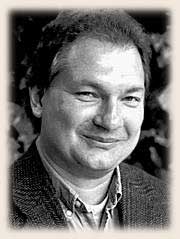 |
William Horwath is a soil organic matter specialist in the Department of Land,
Air and Water Resources at U.C. Davis. His research emphasizes
the role of soil organic matter in controlling soil fertility
and the sustainability and productivity of managed and natural
ecosystems. He uses stable isotopes to understand the carbon
and nitrogen cycling processes that affect soil organic matter
and microbial-plant interactions. |
Horwath said that "carbon sequestration"
is a term used a lot these days that means pulling carbon out of
the air and putting it back in the soil to help alleviate the greenhouse
effect. They are looking for management practices that will help
to do that. But he stated that when carbons are put back in the
soil, it changes the way nutrients cycle through the soil.
Horwath's research has been comparing conventional,
low-input and organic systems, using crops normally grown in that
area (the Sacramento Valley). Inputs in the organic system included
compost, manure and leguminous cover crops. The low-input ("hybrid")
system relies on the cover crops as well as about half of the amount
of inorganic fertilizer as is used in conventional systems.
The conventional treatment uses "the best
of Green Revolution treatments," which he feels have done well
and have fed the world. After 10 years, the organic plot had an
increase of 10 tons of carbon per hectare. The low-input treatment
increased carbon by 5 tons. There was no change in the conventional
plot.
He said the introduction of a cover crop significantly
increased carbon, and when manure was added, the increase was even
greater. And he pointed out that this happened in an increased tillage
situation. As the carbon increases, so does nitrogen. When organic
matter is added, the C:N ratio remains the same. He stated that
these experiments have proven that in a hot, irrigated situation,
carbon can be put back into the soil.
Horwath said that when using inorganic fertilizer
in a conventional method, it is barely possible to get 40% of it
into the crop. But the fertilizer also stimulates micro-organisms
in the soil to release their nutrients. He stated that these are
the types of things we need to know to optimize nutrient management,
when manipulating carbon in the soil. Adding inorganic fertilizer
or manure to a vetch cover crop will increase the uptake of fertilizer
by the following crop by 2-1/2 %, while vetch alone will not affect
the uptake. He believes the data show that low-inputÑa hybrid
of conventional and organic agricultural systemsÑdoes the
best job and that we should look at this without bias.
After 10 years, there are no significant
differences in production of tomatoes and corn between any of these
treatments, which he looked on as a plus for organic and low-input.
They have not yet compared the economics of the different treatments.
top
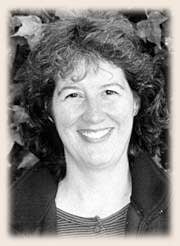 |
Kate Scow is
a professor of soil microbial ecology at U.C. Davis. Her research
includes the influence of environmental variables and management
practices on microbial community structure and function in soils,
and the effects of pollutants and fumigants on microbial populations
in agricultural and contaminated soils. |
Scow first showed a fascinating slide show of
greatly magnified microorganisms in various stages of activity,
as she said, "to whet the audience's interest." She stressed
how important microorganisms are in any kind of system, and particularly
in an agricultural ecosystem the drivers of carbon and energy
flow. Among other functions, they release the nutrients from pulverized
matter in the soil so they can be taken up by plants, help create
soil structure, and fulfill symbiotic relationships with plants.
Scow said that micro-organism activity and biomass are usually greater
in an organic soil.
Scow said there are numerous ways to measure soil
microorganisms, but that she has broken them down into three categories:
- count them,
- measure their activities (the kind of work
they do in their community), or
- look at their guts, break them down into biomass
and measure the resulting nitrogen and carbon.
She said there are new biological methods for
fingerprinting the soil to tell, for example, how a fumigant might
have affected it, or to assess the kind of research mentioned above
by William Horwath.
Scow stated that you can tell the difference
between organic and conventional soil communities but that the biggest
difference is found in the microbe populations that exist in the
soils growing different crops. She said she is now mapping soils
all over California to look at the differences in patterns.
top
Biosphere II
Ed Glenn
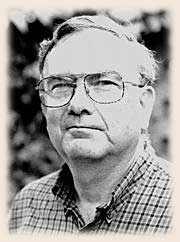 |
Ed Glenn is
a professor at the University of Arizona Environmental Research
Laboratory. He worked on the food-production system for Biosphere
II and is now working on the domestication of halophytes as
seawater crops for coastal deserts. He heads a project studying
ocean plant life in order to see what may happen to our own
oceans in the face of global climate change. |
Glenn was hired to be in charge of setting up
a food-growing system for Biosphere II, an experiment some years
back in which a group of people tried to create and live in a self-sustaining
system within an enclosed area. He learned about the work of Ecology
Action and hired Peter Donelan, an Ecology Action apprentice, to
teach them about GROW BIOINTENSIVE growing.
The GROW BIOINTENSIVE food-growing part of the
project worked well in tests before the Biosphere II program officially
began. However, the group later decided to add an unsustainable
amount of compost to the soil - a 10-year supply - causing the program
to fail during its second year. The compost was not thoroughly decomposed,
and Biosphere II filled up with carbon dioxide.
Glenn said that working with the group was
a most enjoyable experience. In addition, everything was recycled.
Discovering How to Grow More Vegetables by John Jeavons was an eye-opening experience
for him. It was very useful in the Biosphere II design and pilot
project work as well as work he has done since.
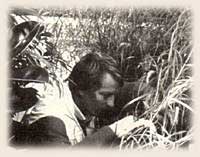 |
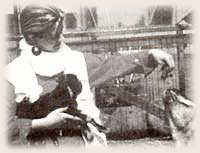 |
Biosphereans
experiment with raising their own food. |
|
A model for
their future "space home". |
[Note: Despite the Biosphere
II's challenges, the people in it, using techniques based in part
on those used by Ecology Action, were able to raise about 83% of
their low-calorie diet during a two-year period within a "closed
system" on approximately 2,957 square feet (274 square meters)
per person. This experience indirectly demonstrated that a complete
year's diet for just one person could be raised on the equivalent
of 3,562 square feet (330 square meters).]
top
Passive Solar Greenhouse
Steve Moore
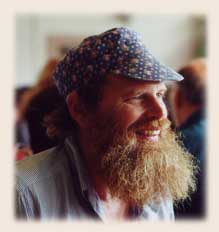 |
Steve Moore is a farmer in Pennsylvania and the former director of the Center
for Sustainable Living of Wilson College, where his work included
teaching, research, and management of a large CSA farm. His
future work will continue to develop the use of GROW BIOINTENSIVE
within a passive solar commercial greenhouse. |
Moore and his wife Carol have been farming organically
for 26 years, using horses for the farm work up until last year.
They also had dairy heifers and were raising pigs for market. The
farming operation included a greenhouse. Twelve years ago, needing
more income, they were considering expanding the greenhouse.
But they started being aware of all the gadgets
the greenhouse contained and that it was taking 1,500 gallons of
propane every 10 days to heat it. They realized they were missing
the mark. They changed their operation and since then have been
growing commercially in a passive solar greenhouse, using no fossil
fuel at all.
|
Steve Moore teaches John
Jeavons about the solar greenhouse's effectiveness. |
Instead, the greenhouse retains its warmth with
double-glazing made of multi-year plastic sheeting. At night, an
additional sheet of plastic is currently placed over all the crops
to further hold in heat. Initially, the greenhouse was heated by
a thermophilic (hot) compost pile, but now a more carbon-efficient
mesophilic (warm) pile is used. In addition, the compost pile has
seedling flats placed on top of it and serves as a "heating
table".
At night, this is covered by plastic sheeting
as well. The greenhouse has grown lettuce in an average of 5-week
cycles (rather than the normal 8-week ones experienced by most people)
- except during the three hottest months of the year - with temperatures
dipping as low as -17 degrees Fahrenheit in its southern Pennsylvania
location.
Moore stated that ten years ago they were struggling,
and following the current advice to "get big," they rented
more ground and bought more horses. Then a neighbor lent Moore a
copy of How To Grow More Vegetables. He thought it was good, but
totally impractical. However, he attended one of John Jeavons' Three-Day
Workshops and has become more and more involved with the method.
He has found that the basic precepts of GROW BIOINTENSIVE
growing - improved soil structure, raised permanent beds, increased
organic matter, close spacing and transplanting - all work well
in a passive solar greenhouse.
Moore said they are experimenting with nutrition
and growing most of their own food. They are focusing on extending
the growing season of plants rather than growing out of season.
After 4 years of growing GROW BIOINTENSIVEly, the soil in the greenhouse
now contains 14% organic matter. And this was soil which was compacted
by machinery while the greenhouse was being built.
Moore feels that using transplants gives them
security, because they know they will have plenty of seedlings at
the right time. He mentioned that they use alfalfa in their compost
to minimize the nitrate level accumulation that can happen in greenhouse
growing. And in the 12 years since they have been using an unheated
greenhouse, they have never had a disease problem.
During the warmer weather, hot weather crops,
such as sorghum, peppers, eggplant and onions, are grown - some
of them in troughs hanging from the ceiling of the greenhouse. Peppers
have produced 6.0 to 11.1 times the U.S. average, eggplant 5.0 to
6.9 times, onions 2.0 times and bok choi 7.4 times.
Moore stated that when he left Wilson College
last December, they sold the last of their horses and committed
themselves fully to the GROW BIOINTENSIVE method. He looks on this
as his version of "downsizing."
top
GROW BIOINTENSIVE Applications Worldwide
GROW BIOINTENSIVE® Applications Worldwide
Julian Gonsalves | Irina
Kim | Juan Manuel Martinez | Emmanuel
Omondi
Fernando Pia | Moises
Cuevas Vasquez | Carol Vesecky
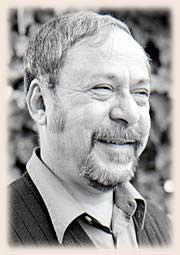 |
Julian Gonsalves works for the
International Institute of Rural Reconstruction and promotes
GROW BIOINTENSIVE practices in the Philippines. |
Gonsalves said that he read How To Grow More Vegetables
over 20 years ago, and attended the 1981 conference co-sponsored
by Ecology Action while still a student at Cornell. He stated that
attending was the best decision he ever made: "It transformed
my life and work."
He returned to the Philippines during the sugar
crisis, when world sugar prices had plummeted. Sugar workers on
the Island of Negros were suffering severely from the crisis. Gonsalves
said that he was able to use GROW BIOINTENSIVE as an entry point
in teaching people to grow their own food.
The program was so successful that the government
redistributed 5,000 acres of land to people for food growing and
eventually initiated a GROW BIOINTENSIVE gardening program in the
schools. Since that time, 23,000 family gardens have been started.
Gonsalves said that the typical garden has 2 double-dug
beds with vegetables grown along the fence line and on trellises.
A row of trees is planted to provide leaves for compost.
He stated that in tropical climates, organic matter
is depleted rapidly, so they suggest that compost be placed deeper
in the soil than normally. Liquid manure is also used because heavy
rains leach nutrients out of the soil quickly.
Gonsalves emphasized that the IIRR functions
as a catalyst. They train the people who train others, and in this
way, 3,000 to 5,000 people a year are taught.
top
 |
Irina Kim is
a soil scientist and teacher of GROW BIOINTENSIVE from Chirchik,
Uzbekistan. She asked to be given time to speak to share her
experiences. |
Kim first called up John Jeavons and presented
him with a traditional robe and hat, as well as hats for his wife
and daughter.
She then described Uzbekistan as a country about
1/100th the size of the U.S. that has economic problems.
In 1994 she received the only copy of the Russian
translation of How To Grow More Vegetables in her country. Kim said
that she immediately understood its importance and it became like
a sacred reference for her. She knew she had to spread the information
as quickly as possible.
Kim was a high school teacher, and she received
permission to teach GROW BIOINTENSIVE as a subject in school. She
also spread the word through the newspapers, magazines and on television.
She wanted this to be a practical skill, too, and therefore she
organized a club for children from 26 schools.
They worked for a long time, from kindergarten
students through the whole school population. There was only the
one book, and she also used it to teach older people twice a week.
Kim said how powerful it is "to think we
can grow our food at our own home - it will save us from starvation."
She expressed her gratitude to the volunteers from the United States
who have come to Uzbekistan to help her teach courses.
[Editor's Note: Addendum from another writing
of Kim's that came to us through Carol Vesecky after the conference:
My experience over five years of studying and
teaching the GROW BIOINTENSIVE method to students and adults has
proven the importance of this technology for Uzbekistan.
I have had positive results in the rooting, growth,
development, and yield of vegetable crops, and have also observed
water conservation: for tomato, cabbage, and pepper, 97%-100%
of the transplants took root in the GROW BIOINTENSIVE beds, while
only 70%-90% took root in the traditional beds.
Crops in the GROW BIOINTENSIVE beds outstripped
the traditional by 150%-200%. GROW BIOINTENSIVE yields for tomato
and cabbage were 1.5 times higher. The traditional beds had to be
watered twice as frequently as the GROW BIOINTENSIVE beds.]
top
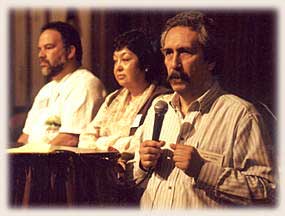
Juan Manuel Martinez is the director of ECOPOL, a
nonprofit organization responsible for initiating and coordinating
all GROW BIOINTENSIVE activity in Mexico and Latin America.
|
| The speakers from Latin America
brought much heart and inspiration to the conference. From left
to right: Padre Julio, Mercedes Torres, and Juan Manuel Martinez. |
Martinez said that he first was introduced to
GROW BIOINTENSIVE in 1983, after investigating several types of
sustainable small-scale agricultural systems. The problem with many
of them was their dependence on chemicals and outside inputs.
He found that GROW BIOINTENSIVE could help people
be independent because they could use resources from within their
community. To prove its worth, he tried it out in one of the most
difficult areas that had poor soil and a high rate of malnutrition
and infant mortality.
Martinez stated that after 5 years of intensive
work in this area, first and second degree malnutrition had disappeared
and infant mortality was reduced. He pointed out that this was not
entirely due to GROW BIOINTENSIVE but that it was instrumental.
Martinez said that 63% of his country is arid,
only 12% is cultivated and of that 12% only 3% is fertile and needs
no irrigation. And this area, he stated, produces export crops.
Martinez gave a slide show of some of the GROW
BIOINTENSIVE work in Mexico, including with the Tarahumara Indians
in Chihuahua state. He pointed out that GROW BIOINTENSIVE is very
similar to the traditional farming methods of the Tarahumara, and
that is the reason it has been so readily accepted by them.
He cited the remarkable figure that about 7 million
people in Mexico have been trained in GROW BIOINTENSIVE mini-farming
practices during the last 11 years.
Martinez ended by saying, "The problems of
the world cannot be solved by skeptics or pessimists. We need men
and women who can dream things that have not yet happened and who
ask themselves 'why not.'"
top
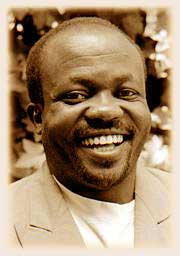 |
Emmanuel Omondi is the director
of Manor House Agricultural Centre near Kitale, Kenya. |
Omondi showed slides during the course of his
presentation to illustrate the many activities of the Centre.
He mentioned that rapid population growth and
less-than-optimal farming techniques have contributed to declining
land quality. He stated that a recent study funded by the World
Bank indicated that 47% of people in rural areas are "absolutely
poor." The study also showed that 60% of Kenyans grow their
own food.
Omondi went on to say that for 15 years Manor
House has been working with the rural poor. The Centre offers a
2-year certificate course in GROW BIOINTENSIVE Agriculture (BIA),
as well as 3-month and 6-week courses and 1-week workshops for farmersÕ
groups and others.
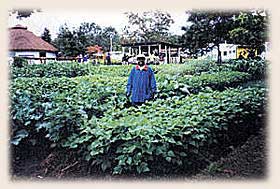
Emmanuel Omondi in garden.
Just before the start of the conference, Manor
House held a field day on its grounds. It was in conjunction with
graduation ceremonies for those who had completed the 2-year course.
Omondi said that about 200 to 300 people generally attend this ceremony,
and this is the number they were expecting, but that this year 1,000
people showed up.
He said they were very encouraged because they
believe it shows that many people in Kenya are waking up to the
need for this kind of high-yield, resource- conserving agriculture.
When Manor House started in 1984, they were the
only ones in Kenya teaching BIA. Now 40 organizations are teaching
it. As of now, over 70,000 Kenyans have been taught directly and
indirectly.
Omondi discussed a research project that Manor
House had initiated among the farmers of Kakamega. Some of the farmers'
comments at the end of the project were:
- they had experienced higher productivity
using GROW BIOINTENSIVE,
- their produce was softer, more palatable,
and of higher quality,
- their health had improved with the addition
of more fruits and vegetables to their diet, and
- their costs using GROW BIOINTENSIVE were
about half of the conventional method costs.
Omondi closed by stating he believes that
"GROW BIOINTENSIVE is the answer to food needs now and forever."
top
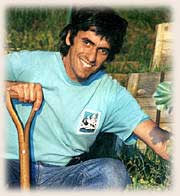 |
Fernando Pia is an agronomic engineer, working for the Rural Extension Service
in Patagonia, Argentina. He is the founder and director of CIESA,
the Center for Research and Demonstration in Sustainable Agriculture. |
Pia began with some facts about soil loss in Argentina:
150,000 acres of topsoil have been lost, and in the richest food-growing
areas of Argentina, 100,000 pounds of topsoil are being lost per
acre per year. He then gave a slide presentation which beautifully
illustrated his talk.
Pia traced his frustrations as an agricultural
extensionist who did not have the solutions that would stem the
migration of indigenous Mapuches from their unproductive land to
the cities or to help people from the cities who wanted to farm
but could not afford the costs of land and equipment that conventional
agriculture required.
Pia talked about attending Ecology Action's Three-Day
Workshop in 1993 and liking what he heard as an answer to some of
the above problems but being skeptical of the results. When he returned
home, he established CIESA and after 3 years of researching the
GROW BIOINTENSIVE method, proved to himself and others that Ecology
Action's claims worked, and worked in Patagonia.
Since then, CIESA has given 16 three-day workshops
for 320 participants. It has also successfully trained apprentices
from the most arid parts of Patagonia in GROW BIOINTENSIVE practices.
These individuals subsequently returned home and established GROW
BIOINTENSIVE demonstration gardens in areas with:
- as little as 5 inches of rain per year,
- high winds, and
- frosts in the middle of the warmer growing
season.
Some of the most impressive slides showed green
gardens growing lushly in the midst of a brown landscape, where
Pia said only 16 inches of rain falls per year and winds reach 90
miles per hour.
Pia described yields in his area as 4 times
higher than the regional average for lettuce, 4 times higher for
potatoes, almost 2 times for cabbage and 3 to 4 times for tomatoes.
top
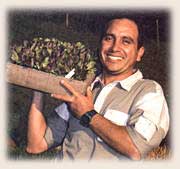 |
Moises Cuevas Vasques is the director of AALTERMEX, in Texcoco, Mexico, and its training
and research center in organic GROW BIOINTENSIVE methods. |
Moises said that AALTERMEX, started in 1989, is
a collaborative effort of the University of Chapingo, ECOPOL, Ecology
Action and the University of Mexico City. The organization is made
up of professors from the two universities, producers, and individuals.
Its purpose is to help small producers towards
self-sufficiency, being aware of all the current problems:
- soil degradation,
- dependency on chemical inputs,
- high costs,
- unemployment, and
- malnutrition.
Vasques said they were first working with organic
agriculture but that has since become such a confusing term and
they found that GROW BIOINTENSIVE means sustainability. It does
because it is based on the scientific principles of agro-ecology,
including management of soil, fertility, vegetable nutrition, and
water, and it is integrated with the existing environmental, social
and economic conditions.
Vasques then showed the results of their research
as a series of graphs, comparing yields and prices received for
domestic and foreign sales for various crops, with and without irrigation,
using both conventional and GROW BIOINTENSIVE methods, in which
GROW BIOINTENSIVE consistently outperformed conventional.
Vasques described AALTERMEX's training courses,
which last from one month to 2 years. The universities have also
given credit and non-credit courses in GROW BIOINTENSIVE. In the
last 10 years, 3,500 people have been taught. The University of
Chapingo has been researching the GROW BIOINTENSIVE method for the
last 5 years and has concluded that it is a method which works for
the small family farmer.
Yields in the 1996-1997 growing season in AALTERMEX
test areas demonstrated Swiss chard yields that were 1.34 times
the Mexican average, beets 2.6 times, broccoli 1.46 times, summer
squash 3.58 times, onions 6.29 times, radishes 2.53 times and carrots
2.69 times.
1997 data also showed a vegetable crop income
potential of US$122 to $1,381 per 1,785 square feet (192 square
meters); and US$6,345 to $71,931 per 2.13 acres (10,000 square meters)Ðdepending
on the type of marketing done. [EditorÕs Note: The legal
urban income in Mexico is approximately US$2,100 and for rural areas
is approximately US$1,000.]
Vasques showed a fax he had just received from
his Department of Agro-Ecology at the University stating it wants
to start offering GROW BIOINTENSIVE as a core course.
top
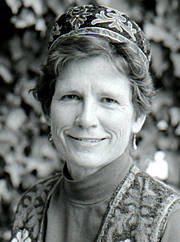 |
Carol Vesecky is the Director of GROW BIOINTENSIVE for Russia. In the mid-1980's,
she became involved in citizen diplomacy activities that led
to her current work promoting GROW BIOINTENSIVE through Russian
language publications and workshops in the former Soviet Union. |
Vesecky talked about small-area dacha gardening,
where city dwellers grow food on suburban plots.
She said that 50% of urban people now have access
to these plots and they are particularly necessary because approximately
30 percent of Russians live in poverty (70% live worse than they
did in Soviet times), and there is a lack of affordable food in
stores. People grow virtually all of their vegetables, fruits and
berries - 50% of their diet - in this way.
Vesecky said that because of the importance of
dacha growing to the people, she helped get How To Grow More Vegetables
translated into Russian. (The translation of the fourth edition
was first published in 1993 and the translation of the fifth edition
in 1999.)
Later in her presentations, she showed slides
of some of these dachas and their bounty, including beautiful canned
fruit and vegetables, which help feed Russians during the winter.
She stressed that Russians truly are master gardeners,
who start seeds on their windowsills in February and plant them
out into coldframes in their dacha gardens during April and May.
Vesecky also spoke about the GROW BIOINTENSIVE
efforts going on throughout the former Soviet Union. She said there
are currently 7 small GROW BIOINTENSIVE centers that are actively
teaching and researching the method. These include ones in Chirchik,
Uzbekistan; Bryansk, Russia; Novo-Sin'kovo, near Moscow; St. Petersburg;
and Novosibirsk, Siberia.
Her slides showed some of the participants at
the workshops that have been given in these centers. She mentioned
that a Summer 2000 Workshop Tour will take place again this year.
top
top
BREAKOUT SESSIONS
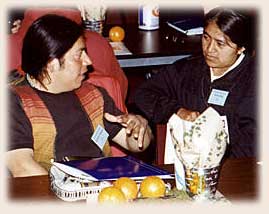 On
Wednesday morning everyone broke into small groups to brainstorm
and develop recommendations for GROW BIOINTENSIVE policy and action
that might be considered. These were the reports that were brought
back to the group as a whole. The recommendations made included: On
Wednesday morning everyone broke into small groups to brainstorm
and develop recommendations for GROW BIOINTENSIVE policy and action
that might be considered. These were the reports that were brought
back to the group as a whole. The recommendations made included:
Agricultural Policy
- Paying the true value of resources used. Disincentives
for inappropriate use of natural resources.
- Subsidies for converting to GROW BIOINTENSIVE.
- Labeling of products that are produced sustainably.
- Incentives to use locally produced food.
Genetic Diversity
- Heritage seeds preserve biodiversity. They
are valuable because most of them come from before the time we
used chemicals and so can be cultivated without using chemicals.
Heritage seed clubs are needed to increase biodiversity. They
would work for the collection and maintenance of seed production
for individuals and seed companies. They should get government
seed bank varieties to the public, strengthen CSA's, train gardeners
and multiply seeds.
- Crop breeding clubs working with horizontal
(poly gene) resistance can produce new varieties with increased
resistance to pests and diseases and thus reduce pesticide use.
Networking
- Include more information in the Ecology Action
website www.GrowBiointensive.org.
- Sponsor nationwide GROW BIOINTENSIVE field
days around the country.
- Develop a teachers' manual for grades K-12.
- Sponsor a national conference every 2-3 years
and an international one every 5 years.
- Think of creative ways to generate funding
for the GROW BIOINTENSIVE projects.
Nutrition
- Buy from local growers.
- Use regional, multi-cultural and traditional
diets.
- Get kids involved. Have school gardens everywhere.
- Link gardens with cooking instruction.
- Create relationships between schools and local
farms.
Research
- Research the major challenges of integrated
systems, including water supply and urban and animal waste.
- Research/demonstration sites should be established
at more locations.
- Find simple "tools" that can be used
by everyone to assess how they are doing in the area of sustainability.
Training, Education and Demonstration
- Describe the key learning steps and phases
of GROW BIOINTENSIVE techniques and relate Ecology Action publications
to them.
- Continue to define target groups and outreach
opportunities.
- Search for people in communities who are the
most receptive to applying GROW BIOINTENSIVE practices, including
young people and elders.
- Encourage the creation of demonstration gardens
with easy public access and visibility, to demonstrate the method
at various stages of development
top
GROW BIOINTENSIVE Friends Old and New
As stated elsewhere in this newsletter,
the conference was attended by wonderful people from all over the
world. We had hoped to talk with many of them, to get updates on
old friends and learn about the work of new acquaintances. However,
time constraints and a full schedule limited the number of contacts
that could be made.
The good news is that we now have names, addresses
and e-mail addresses from the participants list and hope to contact
many people over the next months to get their experiences for upcoming
newsletters.
Take a look below to find out what just a few
of our friends are up to:
Judy Sims
- elementary school GROW BIOINTENSIVE gardening program. |
|
|
 |
Larkin Stentz
- teaching gardening to children - GROW BIOINTENSIVE teacher
certification. |
 |
Boone Hallberg
- experimenting with crossing Opaque2 corn with Mexican varieties. |
 |
Judy Sims
Judy Sims from Santa Barbara attended the Ecology
Action Three-Day Workshop held there in 1998. She has been a teacher
for over 30 years and is involved in the school's gardening program.
At the Sunday evening meeting before the conference
she was talking so passionately about the importance of school gardens
that other people were encouraged to share their own experiences
gardening with children.
One of the Conference participants told Delaine
Eastin, California Superintendent of Public Education, about Judy's
work. Judy is currently a second grade school teacher who teaches
her curriculum through GROW BIOINTENSIVE food-raising including
a small farmers market and the preparation and cooking of the food
grown.
Delaine is working on a publication that helps
teachers infuse their teaching with concepts related to gardening,
nutrition and composting. She visited Judy on April 25 and afterward
noted Judy offers a model program of what the State is looking for
in a garden-based, nutrition-centered education that is cross-curricular.
top
Daniel & Amber Vallotton
Newsletter readers may remember this couple, who attended a Three-Day
Workshop and have spent some of their summers doing GROW BIOINTENSIVE
work in Mexico. Daniel also came to the first Teachers Workshop
at Ecology Action.
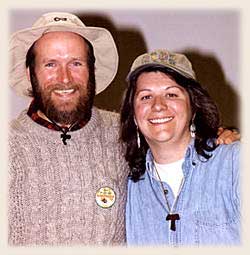 The
Vallottons' big news is that they have finally found the land they
have been seeking for a long time. It is 610 acres in the Chihuahua
desert near Presidio, Texas, just across the Big Bend River from
Mexico and bordering on Big Bend State Park. Amber mentioned that
Gaspar Mayagoitia is only two hours away, in Chihuahua, Mexico. The
Vallottons' big news is that they have finally found the land they
have been seeking for a long time. It is 610 acres in the Chihuahua
desert near Presidio, Texas, just across the Big Bend River from
Mexico and bordering on Big Bend State Park. Amber mentioned that
Gaspar Mayagoitia is only two hours away, in Chihuahua, Mexico.
She said they had been unsure about the type of land they wanted.
They are drawn to green areas, but also love the desert. They had
even considered getting land in Mexico, but found out it is not
legal for foreigners to buy land near the border. When they saw
this land, they were sold.
Amber had many photos that were taken as they walked the land looking
for its corners. In some photos, it was possible to see the mountains
of Mexico in the distance. Others showed a substantial temporary
creek that runs after a rain. But basically, this is arid land that
experiences extremes of wind, heat and quick evaporation.
The Vallottons have wanted for a long time to develop an arid GROW
BIOINTENSIVE demonstration site. Amber said it will be a challenge
to work with the least amount of water and discover the best plants
to grow sustainably at the site. They think there is water, but
they will also develop catchment basins and will watch the vegetation
to figure out the best place to plant their garden. She mentioned
the possibility of developing a sustainable drip system, such as
one made from bamboo.
The biggest challenge they have now is to find funding so that
both of them will be able to work full time on the land and really
get the project underway. Currently, Amber teaches chemistry and
biology at Presidio High School. Daniel is still finishing a project
in Mexico under the auspices of New Mexico University.
top
Larkin Stentz
We wrote several articles in the newsletter quite
a few years ago about the GROW BIOINTENSIVE project Larkin and his
wife Michele were developing in Nayarit, Mexico. At the conference,
Larkin was reminiscing about his long-term relationship with Ecology
Action.
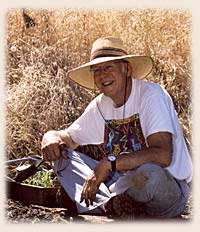 He
said he moved to Palo Alto (a city south of San Francisco that was
the original site of Ecology Action) as a management consultant
and worked for Stanford and then Mt. Zion Hospital. He decided that
he did not want to have to work for a year. He spent some time at
Common Ground Garden Supply and Educational Center where he played
his flute. He played his flute at the Ecology Action's garden as
well. He
said he moved to Palo Alto (a city south of San Francisco that was
the original site of Ecology Action) as a management consultant
and worked for Stanford and then Mt. Zion Hospital. He decided that
he did not want to have to work for a year. He spent some time at
Common Ground Garden Supply and Educational Center where he played
his flute. He played his flute at the Ecology Action's garden as
well.
Larkin also helped double-dig beds for people
in the area and during this time he "got in touch with his
real muse." Larkin never went back to consulting, but was able
to support himself with his music. He played concerts and gave workshops
in 15 countries on 3 continents. The concerts were to help raise
environmental consciousness and to promote music more in harmony
with its surroundings.
Some time later, Larkin and Michele trained for
6 months to prepare them to undertake the Nayarit project. They
were there for 3 years, developing a demonstration garden and teaching
the method. They sold over 150 copies of the Spanish How
To Grow More Vegetables in the little town where they
lived. Their next move was to Port Angeles, Washington, where they
worked on various gardening projects.
Michele passed away a few years ago, but Larkin
has carried on with their work. He attended Ecology Action's Teacher
Certification Workshop in 1998 and today is teaching gardening to
children at an after-school program at the elementary school on
Long Beach Peninsula. He will be using this and other experience
to fulfill the research requirements to become a certified GROW
BIOINTENSIVE teacher at the basic level. At the conference, Larkin
opened several of the morning and afternoon sessions by playing
his flute.
top
Boone Hallberg
Boone Hallberg has spent most of his life in Mexico,
experimenting with crossing Opaque 2 corn with local varieties and
has been able to accomplish this with almost 50 varieties from different
villages. The resultant corn is high in lysine and tryptophane (amino
acids not generally found in corn, which make it a more complete
protein) and is highly productive, as well as resistant to pests
and disease.
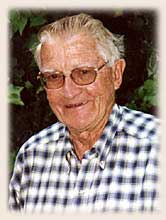 Asked
at the conference what he has been working on lately, he said he
has spent the last 9 years attending international meetings trying
to broaden people's minds about alternative types of farming techniques. Asked
at the conference what he has been working on lately, he said he
has spent the last 9 years attending international meetings trying
to broaden people's minds about alternative types of farming techniques.
With Boone was a young man, Francisco Ramos, who
is a student at the Instituto Technologico de Oaxaca. Francisco
has been surveying local indigenous farmers to find out why they
are still using the older, traditional methods of farming rather
than adopting the "newer" methods.
He said they have told him they are not interested
in making money, but rather in maintaining their self-sufficiency
and growing food for themselves. The families work together to produce
corn as part of their culture. They have been doing this for at
least 500 years without using chemicals.
Manor House Agricultural Centre in Kenya has recently
been experimenting with using some of Boone's Opaque 2 corn as an
alternative to the chemical-compatible corn that for many years
has been the only type available in Kenya.
top
Conference Sponsors
Generous support from the following sponsors
helped to make the Soil, Food, & People Conference a reality.
- Wardlaw Foundation
- C.S. Fund
- Mott-Warsh Legacy Fund
- Lida and Alejandro Zaffaroni
- Sonoma County Community Foundation - Schulz
Donor - Advised Fund
- Irving Foundation
- University Extension University of California,
Davis
- UNICEF
- Wallace Institute for Alternative Agriculture
- CARE International
- Columbia Foundation
- Clarence E. Heller Charitable Foundation
- The Hearst Corporation
- Alice Waters
Conference Food
A
big thank you to Alice Waters who provided the most delicious organic
food for the conference at both breakfast and lunch!
Our compliments to her and her attentive staff.
The meals were definitely a big highlight
of each day!
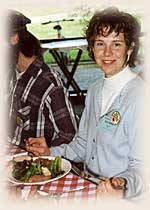
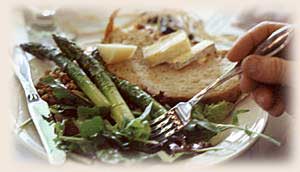

|